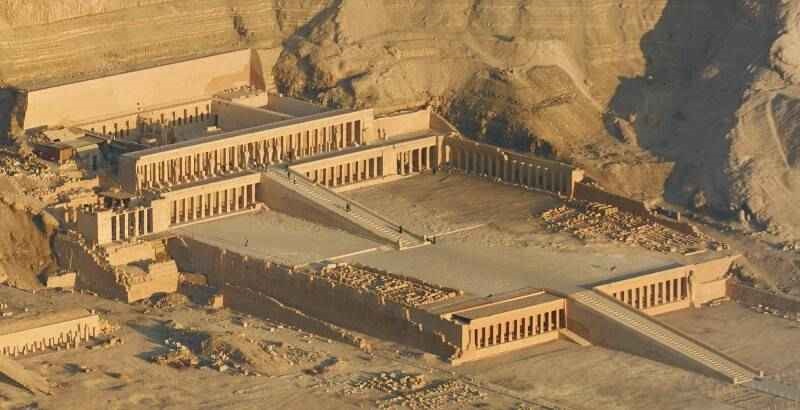 It was the perfect time for a woman to make a move. Her great-grandfather Ahmose had started her family’s dynasty by defeating the barbarians who had so blithely overrun the ancient kingdoms with their new invention, the chariot. It didn’t take Ahmose long to make his own.
It was the perfect time for a woman to make a move. Her great-grandfather Ahmose had started her family’s dynasty by defeating the barbarians who had so blithely overrun the ancient kingdoms with their new invention, the chariot. It didn’t take Ahmose long to make his own.
Her grandfather Amenhotep was therefore able to consolidate rule once again where it belonged, with the rulers of the North who had before the chariot charlatans had ruled for nearly two thousand years. Her father Tutmose solidified a reign that many consider the beginning of the greatest dynasty in all of Egyptian history in part by marrying his favorite daughter, Hatshepsut, to her half-brother, the pharaoh-to-be Tutmose II.
It should have been a simple and splendid arrangement. This fourth generation after the consolidation of the empire in the early 15th century BC saw the royal capital of Thebes as the greatest city on earth. So much trade crossed here from every corner of the universe that Egypt’s wealth was unimaginable. Hatshepsut had a life of leisure and glory, free to enjoy her beauty and grandeur.
But shortly after her husband became pharaoh he died. Hatshepsut had not yet given him a child, but there was a child by an inferior wife, and the two-year old Tutmose III was now technically the pharaoh. Hatshepsut made her move.
It was quick and decisive. She raced through the great new palace at Karnak dismissing anyone who reminded her that thousands of years of tradition would elevate the inferior wife to regent, not her. She surrounded herself with the merchants and builders and caravan traders who were basking in Egypt’s new-found wealth, terrified that a lowly woman could ruin the peace and prosperity of the empire.
So in record time the council declared Hatshepsut regent, certain that this clever woman like many mother regents before her could keep the realm calm until Tutmose III was declared pharaoh when he became 19. Little did they know what Hatshepshut had in mind. And nothing more was ever known of Tutmose III’s real mother. Not even her name survives.
Under Hatshepshut’s regency Egypt’s prosperity grew even greater. There was so much in the royal coffers that Hatshepsut began constructing monuments and temples at a greater rate than any ruler before her. She employed her lover, the great architect Ineni to carve what at the time was the greatest temple every to a reigning Egyptian ruler. The Hatshepshut Temple was carved out of a mountainside.
But thousands of lesser still grand temples were constructed extolling her glory all over the Egyptian empire. Soon her greatness was plastered up and down the Nile, as far away as the frontiers of Byzantine and Greece. The stories she insisted be told on the side of these monuments depicted her as a pharaoh, often as a man, as often as a god.
Although Tutmose III was now 19 the oracle refused to declare him pharaoh. The neglected child had amassed his own court but it was a decadent group of cavalier flatterers and anxious soldiers who Hatshepsut kept supplied with wine and villas but contained none of the traders and builders that were enriching the empire. That was Hatshepsut’s court.
By the 20th or 21st year of her rule Hatshepsut gathered all the royals and nobles and traders in the world to a congregation in the ever expanding temple of Karnak and then walked them to the great mountain Temple of Hatshepsut. There the oracle declared her pharaoh.
She accepted the proclamation in the garb of a man, wearing the horns of a ram and the tail of a god. Many centuries later historians would suggest that she was the second woman pharaoh not the first, but there was no mention of this in her elevation to the divine. To the great center of the earth the first woman ever had become pharaoh.
Two years later Hatshepsut died. Tutmose III, often presumed her poisoner, assumed the throne and immediately ordered that all monuments mentioning his step-mother be defaced or destroyed.
But there were so many monuments it was impossible to accomplish. His generals finally convinced him to channel his anger into empire building rather than stone scratching. He proved greater to the task than any had imagined.
There had never been a pharaoh so successfully militarily as Tutmose III. He nearly doubled the size of the kingdom in two decades and reigned during Egypt’s greatest period.
Although Tutmose III never forgave his step-mother and forbid her name to be mentioned, hundreds of years later the great pharaoh Ramses would resurrect the history of Hatshepsut as the first great woman to rule the earth, who created an empire which prospered from peace and commerce rather than war.